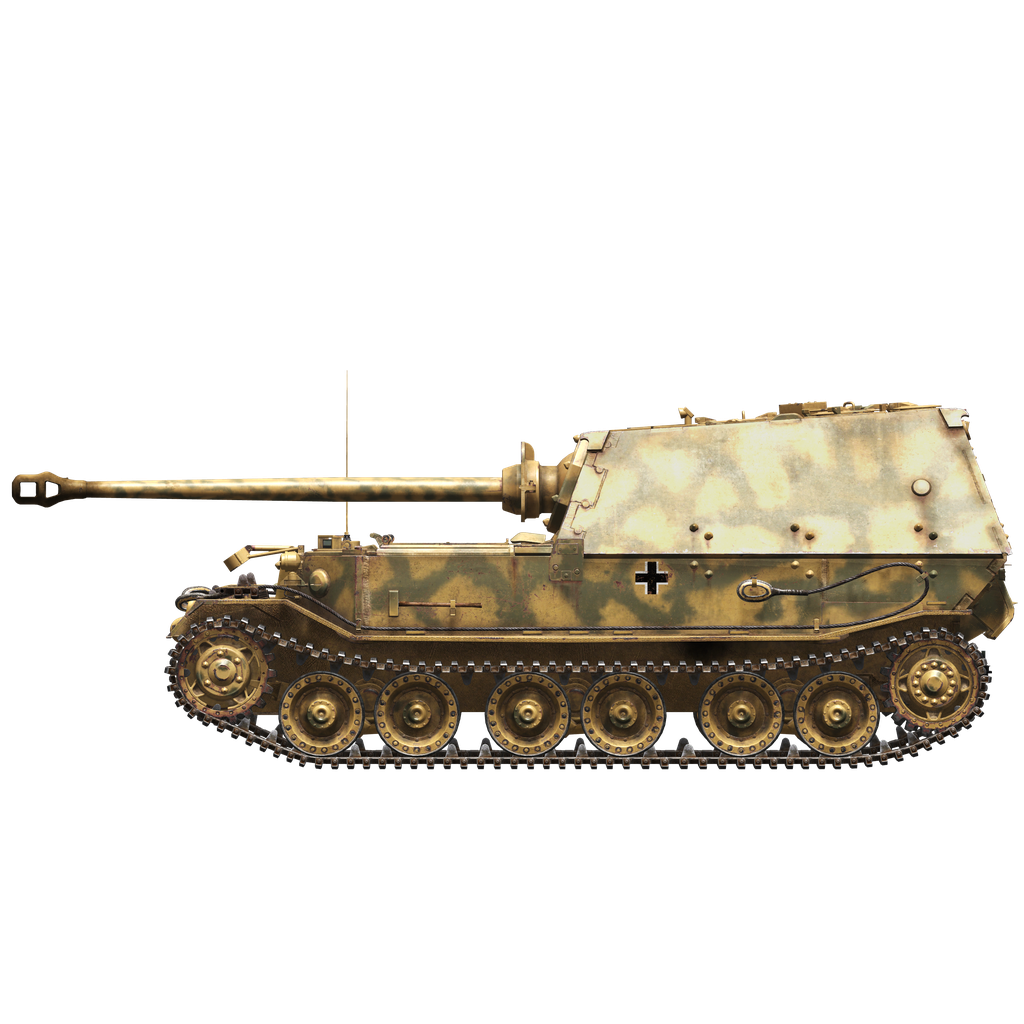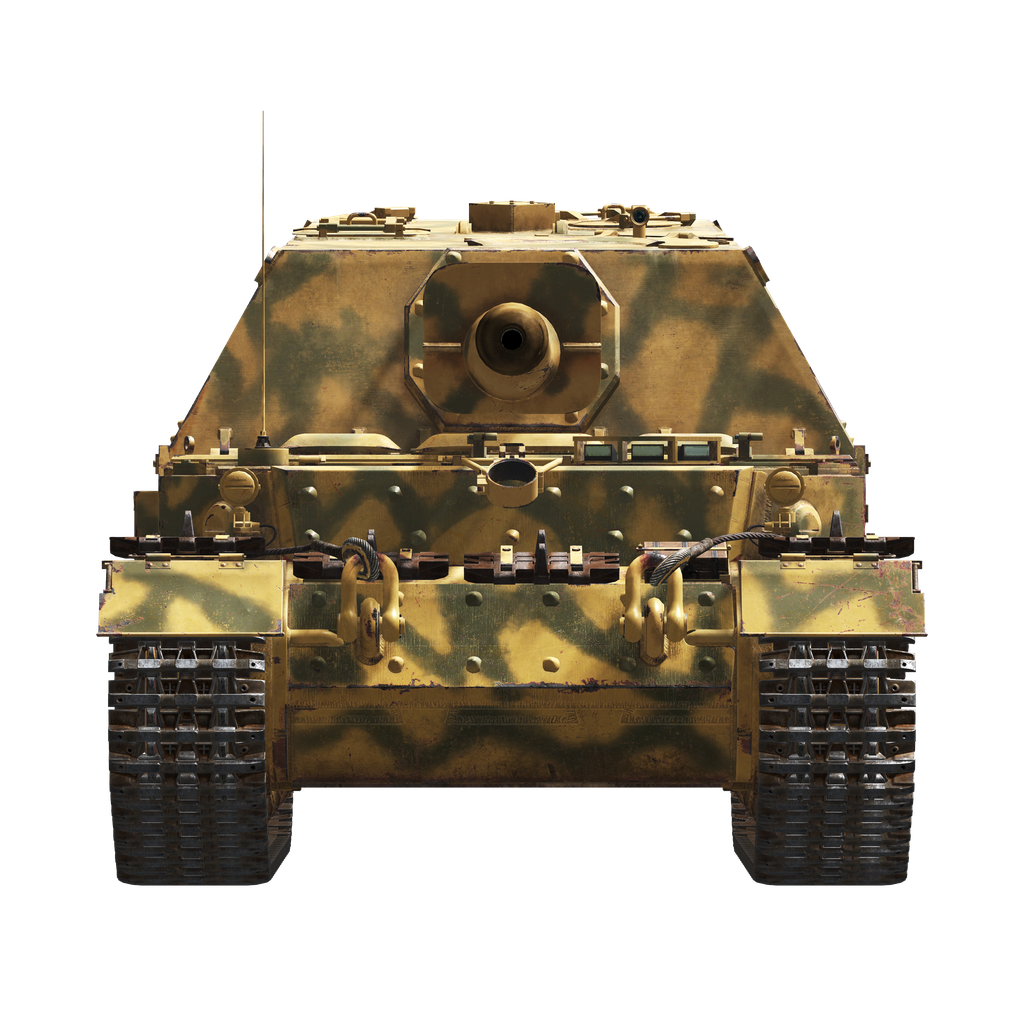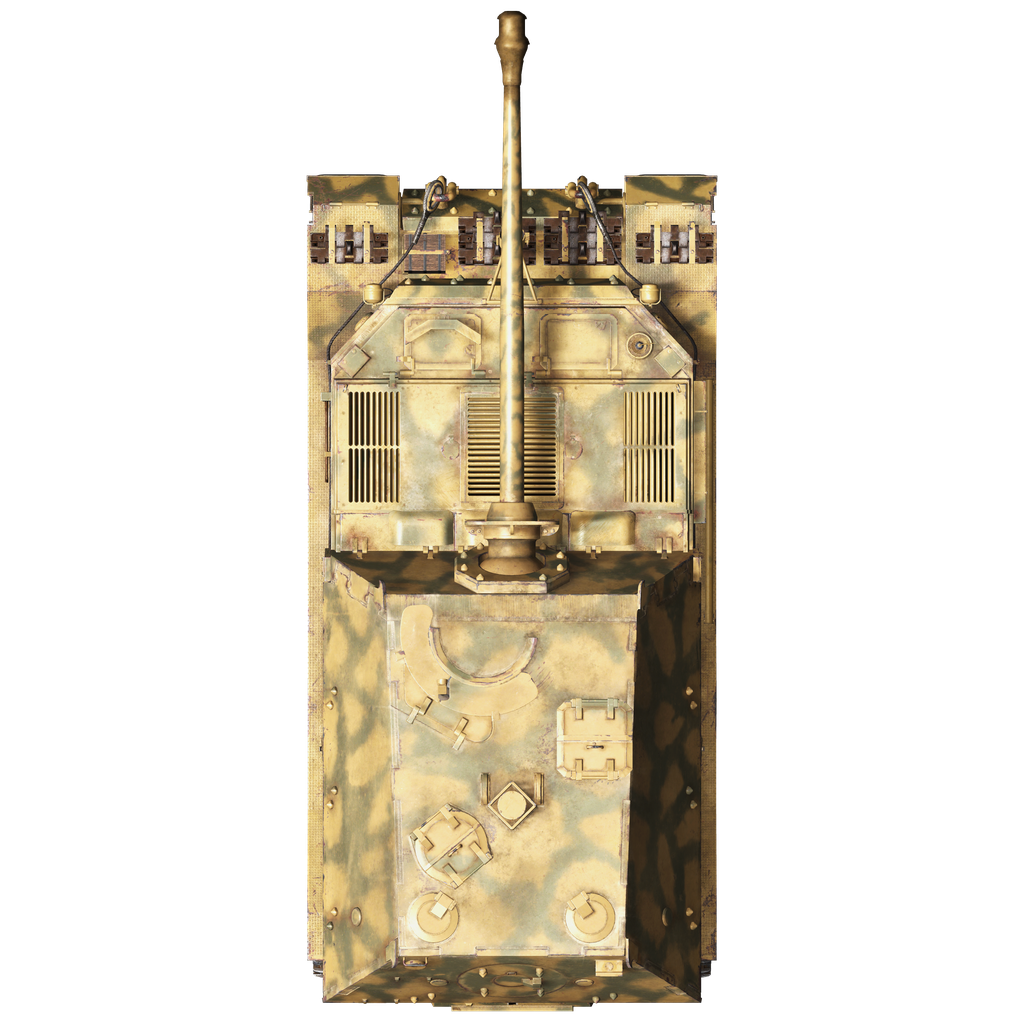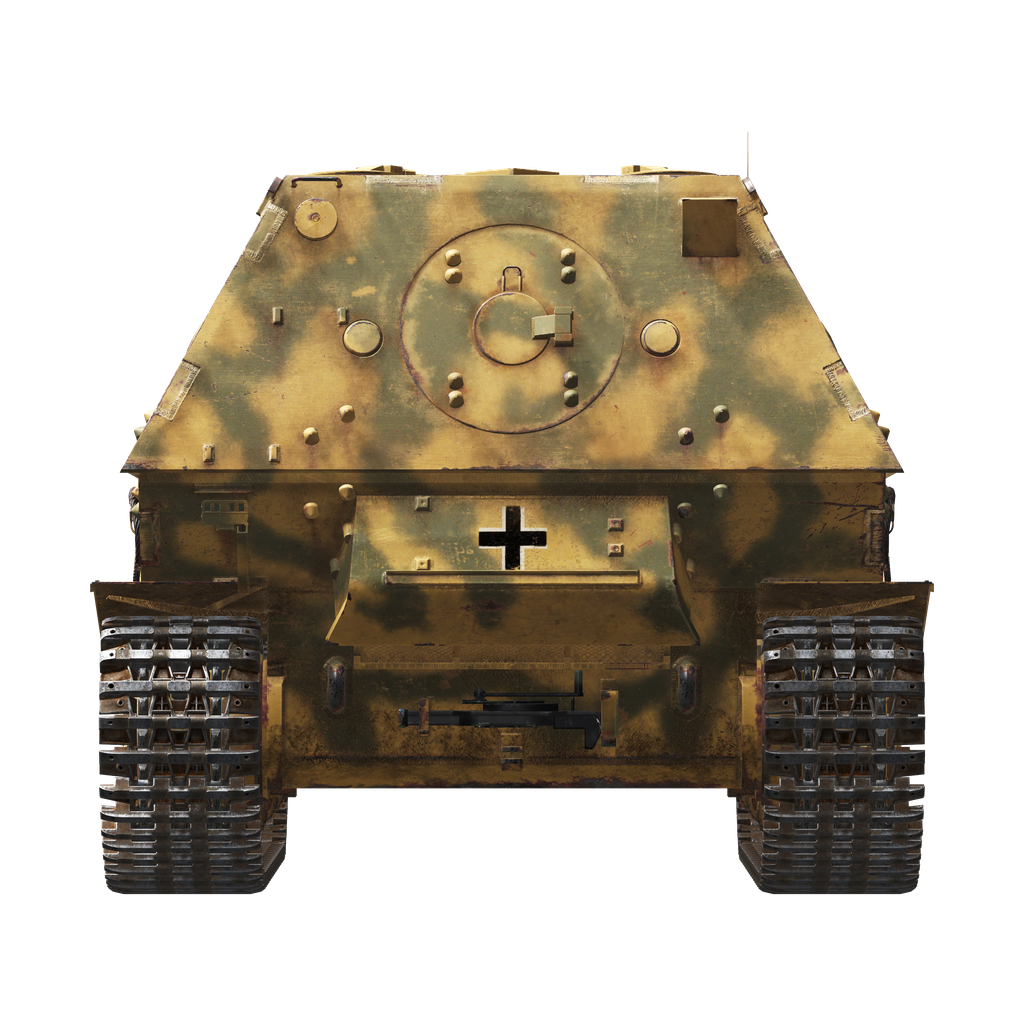In 1942, Henschel’s design won the competition for the new German "Tiger" heavy tank, while the tank VK4501(P) designed by Ferdinand Porsche, characterized by the presence of an electric transmission, lost. However, in addition to 5 prototypes, the Nibelungenwerke plant built 90 hulls of the losing model and it was decided to use them for the production of heavy self-propelled artillery units (SPG). The production of the self-propelled guns was taken over by the Alkett factory in Berlin.
The self-propelled gun was named 8.8 cm Jagdpanzer Tiger(P), and in the end-to-end indexing system of Wehrmacht vehicles — Sd.Kfz.184 and the name "Ferdinand" in honor of the designer of the vehicle.
Divided into three compartments — control, engine, and fighting — the Sd.Kfz.184 had an unusual layout with the fighting compartment located in the rear of the hull.
The control compartment, located in the bow, contained the driver's and radio operator's seats, controls, and a radio station. These two crew members were separated from the fighting compartment by the engine compartment, located behind the armored bulkhead in the middle of the hull. The engine compartment contained two Maybach HL 120TR carbureted engines with a unique electric transmission: they drove two Siemens-Schuckert aGV electric generators. The engine compartment also housed all the equipment necessary for engine operation and an auxiliary electric generator.
The fully armored casemate was located at the rear of the hull. The fighting compartment housed the gun, ammunition, and the remaining four crew members — commander, gunner, and two loaders. In addition, in the lower rear part of the fighting compartment there were D149aAC traction motors, powered by engine compartment generators, which rotated the drive rollers. The fighting compartment was separated from the engine compartment by a heat-resistant partition and a floor with felt gaskets: this design was intended to prevent contaminated air from the engine compartment from entering the fighting compartment and to localize possible fires.
The armament of the self-propelled gun consisted of an 88 mm long-barreled KwK 43 cannon, based on the Flak 41 antiaircraft gun. The ammunition consisted of armor-piercing tracer shells 8.8 cm Pzgr. 39/43 (10.16 kg, 1000 m/s, armor penetration 179 mm at 500 m), 8.8 cm Pzgr. 40/43 (7.3 kg, 1130 m/s, armor penetration 266 mm at close range) and high explosive fragmentation shells 8.8 cm Sprgr. Flak 41 (9.4 kg, 700 m/s).
A total of 90 (according to other sources 91) Sd.Kfz.184s were produced, which entered service with the 656th Panzergrenadier Regiment, consisting of the 653rd and 654th battalions, and were used in the Kursk Bulge. During the offensive at Ponyri 22 vehicles were lost and by the end of 1943 39 self-propelled guns had been lost on the Eastern Front. It turned out that self-propelled guns, capable of destroying almost any Soviet tank from a distance of 3 km, were very vulnerable in close combat against infantry due to the lack of defensive machine guns. At the end of 1943, all vehicles from the Eastern Front were recalled for modifications. A machine gun in a ball mount was installed in the hull front, and a commander's cupola was mounted on the casemate’s roof. The self-propelled guns were renamed "Elephants" and sent to Italy. They were also used in the Ardennes in December 1944 and again on the Eastern Front from spring 1945: at the end of March 1945, 22 vehicles remained in service.
The good protection and excellent antitank capabilities of the self-propelled guns were combined with low mobility and vulnerability of the chassis to mines. On the defense, the Sd.Kfz.184 was very effective due to its ability to hit tanks at a distance of more than 3000 m — on the Western Front, aviation became the main means of countering them, and on the Eastern Front, Soviet tank crews and artillerymen tried to attack them at close range.
Used sources:
1. M. Baryatinsky “Armored vehicles of Germany 1939-1945”, magazine “Armor Collection” No. 2(5) 1996
2. A. Lobanov “Hitler’s Tank Forces” 2010
3. V. Oswald “Complete catalog of military vehicles and tanks of Germany,” 2002.
Heavy tank destroyer Sd.Kfz.184 built at Nibelungenwerke in 1943. This early version lacking commander cupola and a machine gun is known as "Ferdinand", while a later one equipped with these is known as "Elefant". 91 vehicles of all modifications were produced in total.
This self-propelled artillery was created to make use of the numerous "Tiger (P)" tanks chassis that were built for a new German heavy tank, but were left unused when the German authorities chose a competing design. This chassis had a unique electromechanical transmission, which, while being cutting-edge for its time, had many disadvantages - a significant drop in efficiency as the speed increased was the main one. This led to a very limited operational range and driving speed. However, "Ferdinand" was the most armored combat vehicle at the time of the Kursk battle. Its only weapon was long 88mm KwK 43 main gun designed on the basis of Flak 41 AA gun - its muzzle energy was more than 1.5 times higher than the muzzle energy of KwK 39 installed on Tiger tanks. As a result, armor-piercing rounds fired from it could knock out any armored vehicle of its time at any distance up to the maximum aiming distance. The early production vehicles had serious problems with the field of vision: the gunner used a periscopic gunsight with a very limited field of view while the commander had no optical visors usable with a closed hatch. Two loaders had periscopes for looking backward (in the game they can be used by the gunner and commander).
At the Kursk battle, Sd.Kfz.184 was the most armored combat vehicle armed with the best anti-tank weapon, but they failed to make a decisive impact on the battle outcome because their numbers and mobility were limited.
Unladen weight: 67000 kg.
Length: 8.2 m.
Width: 3.4 m.
Height: 3.0 m.
Clearance: 479 mm.
Engine: 2 x Maybach HL 120TRM, petrol.
Maximum power: 2 x 300 HP at 3000 RPM.
Maximum RPM: 3000 RPM.
Electromechanical transmission including two 250 kW DC traction generators, each attached to it's own engine. Generators are powering the joint powerline which feeds two DC driving motors - one per side.
Powerplant has 3 power modes:
1st: beginning of the movement, low-speed turns and driving on stiff slopes.
2nd: acceleration and driving on difficult terrain.
3rd: general driving mode.
Maximum allowed road speed: 20 kph.
Maximum offroad speed: 11 kph.
Endurance range: 150 km.
Fluids:
Internal fuel tanks capacity: 950 l.
Engine oil system capacity: 50 l.
Summer engine coolant: 200 l. of 40% glysantin
Winter engine coolant: 200 l. of 60% glysantin
Maximum oil consumption: 22 l/h.
Hull armour:
Gun mantlet: 100 mm cast armour + 30 mm rolled armour screen.
Cabin front: 100 mm + 100 mm rolled armour.
Hull front: 100 mm + 100 mm rolled armour.
Upper sides: 80 mm rolled armour.
Lower sides: 60 mm rolled armour.
Rear: 60 mm rolled armour.
Rear, armouring of cooling exhaust of electromotors: 45 mm rolled armour.
Frontal roof: 30 mm rolled armour.
Rear roof: 30 mm rolled armour.
Bottom, forward: 50 mm rolled armour.
Bottom, rear: 25 mm rolled armour.
Bottom above tracks: 25 mm rolled armour.
Main gun: rifled, 8,8 cm KwK 43 L/71.
Barrel length: 58.5.
Elevation: +15°..-7.5°.
Azimuth: +12°..-12°.
Ammo: up to 50 rounds.
Usable rate of fire: 6 rounds per minute.
Turret drive: mechanical.
Gun ammunition:
8,8 cm Pzgr. 39/43 armour piercing high explosive (APHE): 10.16 kg, 1000 m/s, 179 mm at 500 m.
8,8 cm Pzgr. 40/43 armour piercing composite rigid (APCR): 7.3 kg, 1130 m/s, 266 mm point blank.
8,8 cm Sprgr. Flak 41 high explosive (HE): 9.4 kg, 700 m/s, 1 kg explosives.
Gunsight settings for Sprgr. Flak 41:
(Distance - point number of upper scale):
0000m - 000
0100m - 001 4100m - 060 8100m - 182
0200m - 002 4200m - 062 8200m - 186
0300m - 003 4300m - 064 8300m - 190
0400m - 004 4400m - 066 8400m - 195
0500m - 005 4500m - 068 8500m - 200
0600m - 006 4600m - 070 8600m - 205
0700m - 008 4700m - 072 8700m - 210
0800m - 009 4800m - 075 8800m - 215
0900m - 010 4900m - 077 8900m - 220
1000m - 011 5000m - 080 9000m - 225
1100m - 012 5100m - 082 9100m - 231
1200m - 014 5200m - 084 9200m - 236
1300m - 015 5300m - 087 9300m - 241
1400m - 016 5400m - 090 9400m - 247
1500m - 017 5500m - 092 9500m - 253
1600m - 019 5600m - 095 9600m - 259
1700m - 020 5700m - 097 9700m - 265
1800m - 021 5800m - 100 9800m - 271
1900m - 023 5900m - 103 9900m - 277
2000m - 024 6000m - 106 10000m - 284
2100m - 025 6100m - 109 10100m - 290
2200m - 027 6200m - 112 10200m - 297
2300m - 028 6300m - 115 10300m - 303
2400m - 030 6400m - 118 10400m - 311
2500m - 031 6500m - 121 10500m - 318
2600m - 033 6600m - 124
2700m - 034 6700m - 127
2800m - 036 6800m - 131
2900m - 038 6900m - 134
3000m - 039 7000m - 138
3100m - 041 7100m - 142
3200m - 043 7200m - 145
3300m - 045 7300m - 149
3400m - 046 7400m - 153
3500m - 048 7500m - 157
3600m - 050 7600m - 161
3700m - 052 7700m - 165
3800m - 054 7800m - 169
3900m - 056 7900m - 173
4000m - 058 8000m - 177
Gunsights:
Sfl ZF 1a gunner periscopic sight, field of view 8°.
Radio equipment:
VHF Fu 5 transceiver.
5 intercom terminals.





